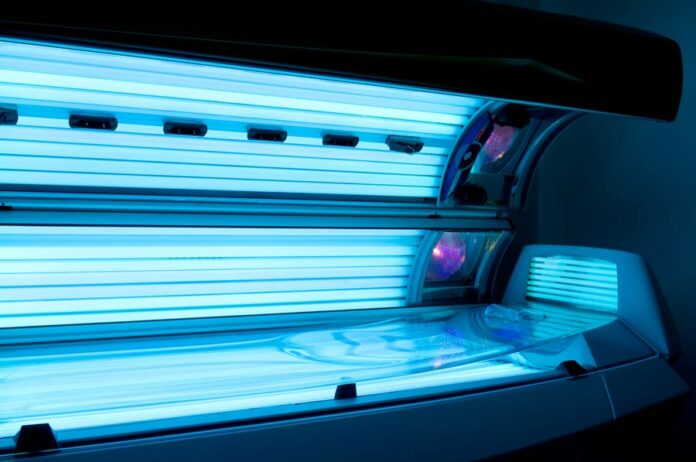
Everyone wants to praise the sun in order to get that beautifully tan beach body. But not all of us are lucky enough to have access to a beach. Heck, lots of us have a tough time even getting access to a sunny, scenic lake or an outdoor pool. And on top of that, you have to consider how much time it takes for Mother Nature’s natural rays to interact with your skin and banish your pasty-white winter pallor. For some, it can take hours. And, frankly, who has time to sweat out in the heat like that all day?
Hence the popularity of the modern tanning salon. For 10-15 minutes a day, you can pay a small fee and get that perfect beach bunny hue in about a week. Artificial tanning beds are lined with UV bulbs, which are several times more powerful than actual sun rays, and blast your skin with ultraviolet light. This stimulates the melanocytes in your skin to work overtime. Most people can notice a difference after their very first visit (especially if you apply one of those cute little stickers and give yourself a “tan tattoo”).
But before you rush on over to book your first tanning session, be wary. New medical research from some pretty big organizations – including the FDA, the CDC, and the WHO – claims that these tanning beds could be a hazard to your health. Below, we’ll explain why artificial tanning is being linked to rising rates of skin cancer, as well as how to evaluate your personal risk.
Tanning Beds and Skin Cancer: What the Experts Say
Many experts, including the US Food and Drug Administration, the Center for Disease Control, and the World Health Organization look at artificial tanning in the same way they do cigarettes: an unnecessary cultural phenomenon that is giving us all cancer. Specifically:
- Over 400,000 new cases of skin cancer popped up in 2014 alone
- One single tanning session can increase your skin cancer risk by nearly 60%
- The effects are cumulative: the more you tan, the higher your risk of developing cancer at a younger age
And these are just a few of the frightening statistics which large and small organizations alike are trying to use in order to discourage all forms of UV exposure. Health experts claim that any darkening of your skin which was stimulated by ultraviolet light is unhealthy and damaging. But because it would be impossible to block out the sun, their anti-tanning crusade is mostly aimed at artificial tanning salons.
How to Calculate Your Actual Risk
So, is artificial tanning really as dangerous as they say? Are tanning beds as likely to give you skin cancer as cigarettes are to give you lung cancer/disease? While the numbers above are pretty frightening, you may have less to worry about if:
- You don’t tan on a regular basis. Whether you’re doing it indoors under a UV lamp or praising the sun in person, limiting your overall UV exposure is your best bet.
- You have a naturally dark complexion – if you were born with active melanocytes and you don’t need to expose yourself to the sun in order to maintain your natural color, you’ll not only be limiting your sun exposure (as mentioned above) but the UV rays you do encounter will affect you less.
- If you didn’t start artificially tanning until later in life, your risk is smaller than those who start young. Many areas are now banning minors from salons – kind of like how some countries enforce age restrictions on tobacco products.
- If you keep track of your freckles and moles, and talk to your doctor about any unusual spots that pop up. Make sure you follow the ABCD rule, and point out any asymmetrical, discolored, large moles or freckles with irregular-shaped borders.
But Isn’t Some Sun Exposure Supposed to be Healthy?
That depends on who you ask. Many of the experts who have studied humans and UV exposure adhere to the fanatical belief that all exposure is bad, all the time, with no exceptions. But human beings evolved on a planet – for thousands of years – where virtually all life is powered by the sun. Seasonal Effective Disorder is a form of depression in people who don’t get enough sun exposure. Too little sun exposure can have a severe (and often, negative) impact on our sleep rhythms. Lastly, Vitamin D deficiency is becoming a growing problem in areas where people are well-educated about the health risks associated with excessive UV exposure. However, not getting enough Vitamin D has a plethora of health risks associated with it… including premature aging and increased cancer risks.
The best advice is to keep an active conversation open with your doctor and/or dermatologist. Do what you can to keep your skin cancer risks low, but don’t sacrifice your emotional well-being, your sleep cycle, or your ability to get enough Vitamin D. If you can keep this delicate balance in check, you can lead a long and healthy life.






